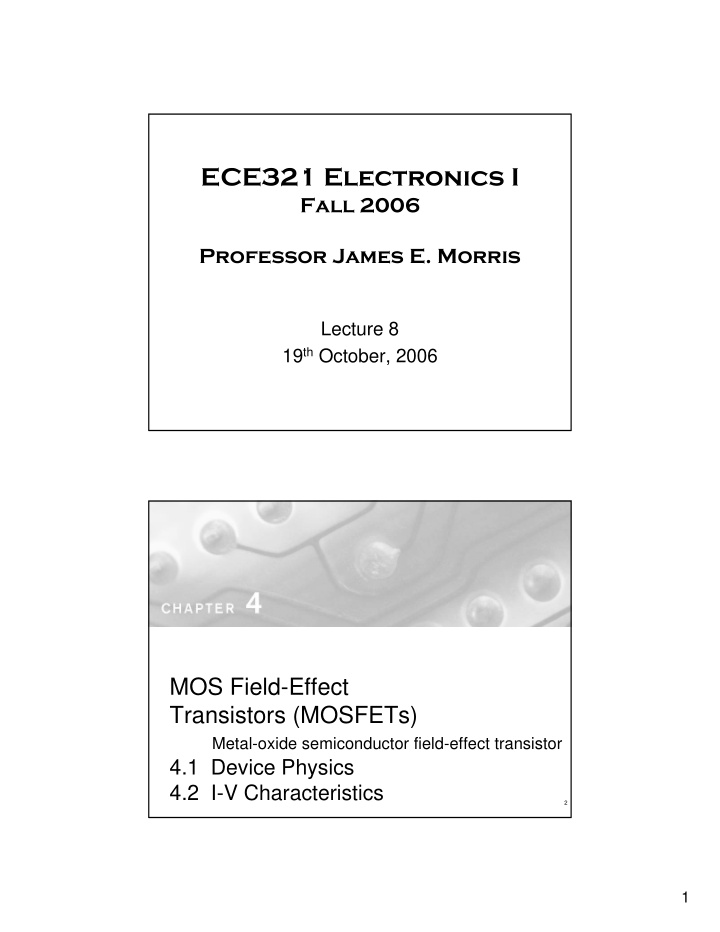



ECE321 Electronics I Fall 2006 Professor James E. Morris Lecture 8 19 th October, 2006 MOS Field-Effect Transistors (MOSFETs) Metal-oxide semiconductor field-effect transistor 4.1 Device Physics 4.2 I-V Characteristics 2 1
Figure 4.1 Physical structure of the enhancement-type NMOS transistor: (a) perspective view; (b) cross-section. Typically L = 0.1 to 3 µ m, W = 0.2 to 100 µ m, and the thickness of the oxide layer (t ox ) is in the range of 2 to 50 nm. Figure 4.2 The enhancement-type NMOS transistor with a positive voltage applied to the gate. An n channel is induced at the top of the substrate beneath the gate. 2
Figure 4.3 An NMOS transistor with v GS > V t and with a small v DS applied. The device acts as a resistance whose value is determined by v GS . Specifically, the channel conductance is proportional to v GS – V t ’ and thus i D is proportional to ( v GS – V t ) v DS . Note that the depletion region is not shown (for simplicity). Figure 4.4 The i D – v DS characteristics of the MOSFET in Fig. 4.3 when the voltage applied between drain and source, v DS , is kept small. The device operates as a linear resistor whose value is controlled by v GS . 3
Figure 4.5 Operation of the enhancement NMOS transistor as v DS is increased. The induced channel acquires a tapered shape, and its resistance increases as v DS is increased. Here, v GS is kept constant at a value > V t . Figure 4.6 The drain current i D versus the drain-to-source voltage v DS for an enhancement-type NMOS transistor operated with v GS > V t . 4
Figure 4.7 Increasing v DS causes the channel to acquire a tapered shape. Eventually, as v DS reaches v GS – V t ’ the channel is pinched off at the drain end. Increasing v DS above v GS – V t has little effect (theoretically, no effect) on the channel’s shape. Figure 4.8 Derivation of the i D – v DS characteristic of the NMOS transistor. 5
Figure 4.9 Cross-section of a CMOS integrated circuit. Note that the PMOS transistor is formed in a separate n -type region, known as an n well. Another arrangement is also possible in which an n -type body is used and the n device is formed in a p well. Not shown are the connections made to the p -type body and to the n well; the latter functions as the body terminal for the p -channel device. Figure 4.10 (a) Circuit symbol for the n -channel enhancement-type MOSFET. (b) Modified circuit symbol with an arrowhead on the source terminal to distinguish it from the drain and to indicate device polarity (i.e., n channel). (c) Simplified circuit symbol to be used when the source is connected to the body or when the effect of the body on device operation is unimportant. 6
Figure 4.11 (a) An n -channel enhancement-type MOSFET with v GS and v DS applied and with the normal directions of current flow indicated. (b) The i D – v DS characteristics for a device with k’ n ( W / L ) = 1.0 mA/V 2 . Figure 4.12 The i D – v GS characteristic for an enhancement-type NMOS transistor in saturation ( V t = 1 V, k’ n W / L = 1.0 mA/V 2 ). 7
Figure 4.13 Large-signal equivalent-circuit model of an n -channel MOSFET operating in the saturation region. Figure 4.14 The relative levels of the terminal voltages of the enhancement NMOS transistor for operation in the triode region and in the saturation region. 8
Figure 4.15 Increasing v DS beyond v DS sat causes the channel pinch-off point to move slightly away from the drain, thus reducing the effective channel length (by D L ). Figure 4.16 Effect of v DS on i D in the saturation region. The MOSFET parameter V A depends on the process technology and, for a given process, is proportional to the channel length L . 9
Figure 4.17 Large-signal equivalent circuit model of the n -channel MOSFET in saturation, incorporating the output resistance r o . The output resistance models the linear dependence of i D on v DS and is given by Eq. (4.22). Figure 4.18 (a) Circuit symbol for the p -channel enhancement-type MOSFET. (b) Modified symbol with an arrowhead on the source lead. (c) Simplified circuit symbol for the case where the source is connected to the body. (d) The MOSFET with voltages applied and the directions of current flow indicated. Note that v GS and v DS are negative and i D flows out of the drain terminal. 10
Figure 4.19 The relative levels of the terminal voltages of the enhancement-type PMOS transistor for operation in the triode region and in the saturation region. / = 60µA/v 2 Exercise 4.8 PMOS V t = -1v k p W/L = 10 Figure E4.8 11
Table 4.1 12
Recommend
More recommend